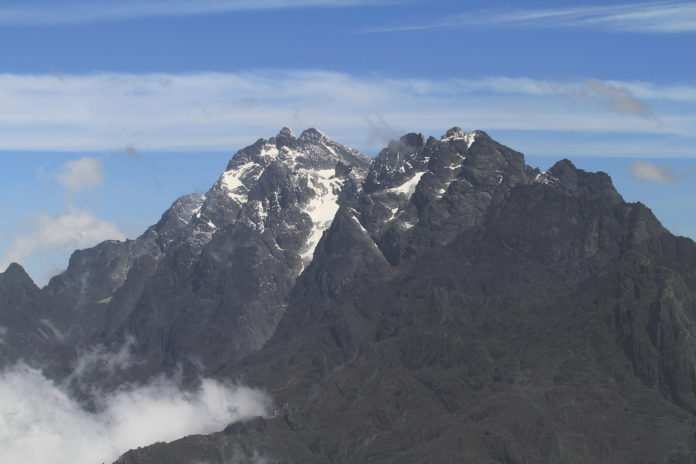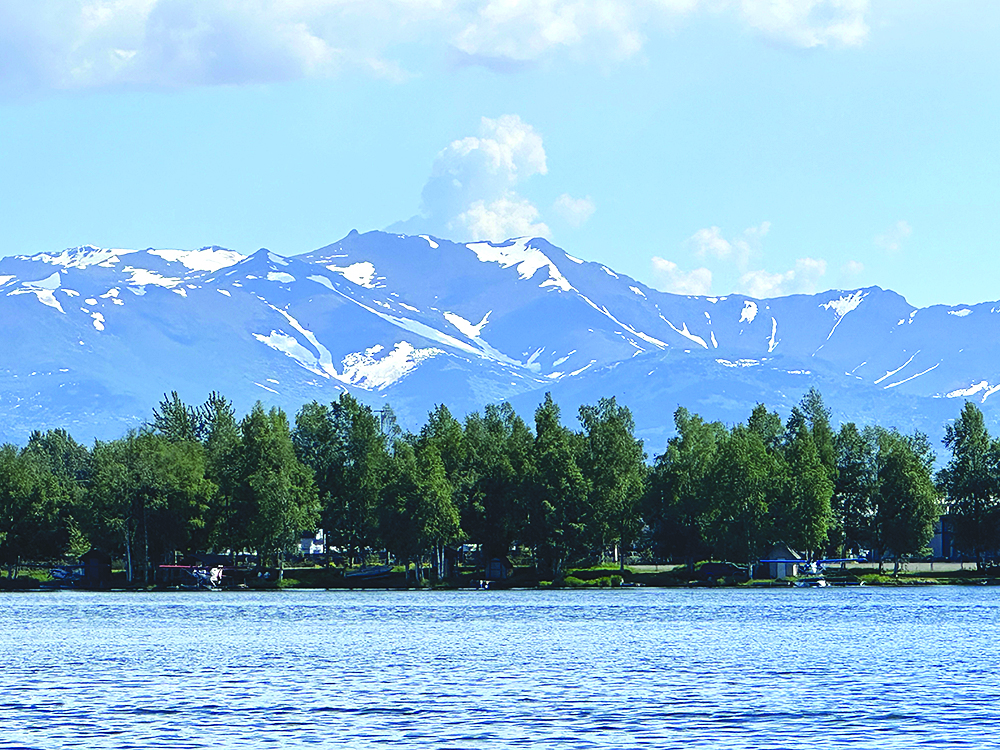
PEAK PERFORMANCE Margherita Peak (elev. 16,763 feet) is the highest summit on Mount Stanley in the Rwenzori Range of Uganda.
Story and photos by Chuck Graham
It was raining monkeys. To be specific, it was raining colobus monkeys. They were literally flinging themselves through the air, 50 to 70 feet, from tree to tree, leaves drifting downward on top of us. Between the cascading river and the colobus thrashing through the treetops, the rainforest of the Rwenzori Mountains in Uganda was nearly deafening.
That was just one of the many unexpected moments experienced while trekking through knee-deep muddy bogs between 10,000 and 14,000 feet. The entire Rwenzori Mountain Range is full of unknowns while climbing up to Mount Stanley and its highest summit: Margherita Peak which, at 16,763 feet, is the highest summit in Uganda.
I had good luck convincing friends Craig Fernandez, 52, and Danny Trudeau, 65, to accompany me on my 15th trip to Africa, the Rwenzoris having played on my mind since February 1990. That’s when the film Mountains of the Moon was released. Starring Patrick Bergin as Richard Francis Burton and Iain Glen as John Hanning Speke, the two English explorers were on an unforgettable quest in 1857-58 to discover the true source of the Nile River. It was a brutal journey full of hardships and eventually the two men became bitter rivals.
The Rwenzori Mountains were mentioned on multiple occasions in the writings of Burton and Speke. After several more difficult expeditions into Africa’s central interior, it was Speke who was credited with the discovery of Lake Victoria, the source of the Nile…although a small portion of the Rwenzori also feeds the Nile. Today the mountain range is known as a World Heritage Site.

According to Wikipedia, the first successful ascent of Margherita Peak was in 1906, led by Italian Luigi Amedeo and (presumably) why the Margherita Peak was named after Queen Margherita of Italy.
Along the Boardwalk
Rwenzori Trekking sternly warned potential trekkers and climbers that the terrain was steep and difficult, with lots of muddy bogs.
After summiting Mount Kilimanjaro twice (1996, 2009) and Mount Kenya once (1997), it became clear to me while slogging it out in gooey mud for a week that the Rwenzori required more effort to reach its tallest peak. In fact, the Rwenzori possesses six of Africa’s 10 highest summits, with Margherita Peak being the third highest in all of Africa.
From the moment we left the Trekkers Hostel in Kilembe at 4,785 feet with our guides Samuel and Rogers, we began our ascent through the incredible vegetation zones for which the Rwenzori Range is known. The walk leading into the rainforest was brimming with smiling, laughing and playful Ugandan kids, my digital camera being all the rage while playing back all those beautiful, curious smiles.
Beyond the rainforest, those thick stocks of bamboo sure came in handy while ascending the narrow spines of so many steep ridges. They provided sturdy handholds when the ground became steep, muddy and slippery. It felt like we were trekking the back of some type of massive sea serpent, its rolling spine never ceasing until we reached our first overnight at Kalalama Camp at 10,276 feet.
Most impressive during this time were all the mountain guides and porters lugging up huge packs and bags of food and other essentials to all the camps hidden in the vegetation zones spread throughout the higher elevations. Not one of the porters were without a smile or experienced a misstep on the ever-changing landscape, always offering a hello even when the terrain was at its most challenging.

The guides and porters also doubled as trail crews, taking their turns to maintain some sort of semblance of order on the trails. They’ve done a superlative job of constructing long sections of boardwalks above some of the worst of the bogs, but also building ladders up and down some of the exposed ascents and down-climbs.
Trekking across the moorlands was stunning though. Giant lobelias, forests of giant groundsel trees, endless mounds of tussock grasses, Saint John’s Wort and other vegetation dominated the mountainscapes. The elevated boardwalks themselves limited any impact on the unique vegetation, while the raised platforms also enhanced our ability to soak in the grandiose landscape.
Bamwanjara Pass
Above 13,000 feet we began to experience several alpine lakes hidden in the Rwenzori. The first one we came across was Bugata Lake. It seemed every lake was an excellent place to spot some of the range’s impressive birdlife. More than 1,000 species of birds have been documented in Uganda, representing over half of the species found on the entire continent. One of those was the brilliant scarlet-tufted malachite sunbird, an endemic bird to the high-altitude zones of East and Central Africa. Its curved beak, forked and elongated tail and shimmering feathers made it stand out against the vegetation, especially around the giant lobelias where they enjoyed the plants’ sweet nectar.
From there we soaked in the epic views from Bamwanjara Pass at 14,685 feet. It was exceptionally impressive because it gave us the first real look across a deep valley toward the high peaks of Margherita, Mount Stanley, Mount Baker and Mount Speke, all with swirling plumes of wispy clouds ascending skyward. Then it was a slow, muddy, 2,000-foot descent before finishing down a series of well-placed ladders. From there, it was another muddy 500-foot ascent to Hunwicks Camp at 13,114 feet.
Into the Mist
Hunswick Camp was situated on a convenient plateau overlooking a boardwalk splitting two craggy peaks with three lakes, the trail hugging the right side of the lakes. The giant groundsel forests were tall and clustered leading to Margherita Camp. It was our shortest day of trekking, and we were grateful for the opportunity to rest before the ascent to the summit.

To reach the top of Margherita, we were up at 1 a.m. Headlamps burning bright, Craig, Danny and I placed one foot in front of the other. I’ve always theorized that it’s better to ascend in the dark because you can’t see how far you need to go, and the darkness doesn’t reveal how difficult the terrain might become. I relayed my theory to Danny and Craig, and they bought into it with a subtle nod or a reluctant thumbs up as we traversed our first glacier, our breaths wafting above our headlamps.
All the other climbing teams were behind us when visibility deteriorated to less than 25 feet.
Once we reached the overhanging portion of Margherita glacier, visibility decreased. From there it was a snow-covered, rocky scramble to the summit. If it had been clear, we would’ve been able to look across to Bamwanjara Pass to where we stood two days prior. Instead, we settled for milling around a frigid summit at 16,763 feet.
An Animalistic Descent
Sometimes it’s tougher descending. It’s more taxing on the joints than catching your breath at altitude. A nice, long scree slope would’ve been more enjoyable.
That was clearly the case in the Rwenzori. Many of those descents were in slippery mud. We had been lucky up to that point not to endure any rain. However, once we left Hunswick Camp, we were in a lot of mud, steady rain and intermittent snow. We were on a different route and two days away from the trekking hostel. We trekked up and over Oliver’s Pass at around 15,000 feet. From Hunswick it was almost a 2,000-foot ascent to the top of the pass, the mud delivering a lasting impression to each plateau, through narrow gorges where giant groundsels soaked in all the moisture. They acted as natural water catchments and I occasionally sipped from those smooth, waxy leaves.
While we made the arduous descent, we experienced some nice diversions. Once back in the rainforest, the head porter, Paul, and I veered off briefly on an alternate route for more birding. That produced a cinnamon-chested bee-eater and another sunbird, this one a red-chested sunbird.

Then, without any warning, Paul spotted in dense vegetation a pair of blue monkeys tight roping with utter aplomb along a narrow, elongated branch. Once they spotted us, they made a point of creating a lot of noise either by their own vocalizations or thrashing through the rainforest.
Danny, Craig and I did make a special request to the guides and all the porters. We wanted to see a chameleon, which initially felt like spotting a dime at the bottom of the ocean, but they came through in a pinch. Not just one, but two different species of chameleons within a few feet of each other. A three-horned chameleon scaled the sleeve of Rogers. The larger species was a giant chameleon. Away from vegetation it flashed at least six different colors. Once back in the rainforest it blended in only like a chameleon can, vanishing in the rainforest of the Rwenzori, brimming in natural wonders from its highest peaks to its smallest inhabitants.
Rwenzori Mountains and National Park
Plot 7 Kira Road
P.O. Box 3530, Kampala, Uganda
(+256) 312 355000
info@wildlife.go.ug
ugandawildlife.org/tours/rwenzori-mountains/
Rwenzori Trekking Services
6a Senkaaba Lane, Kampala, Uganda
(+256) 772 662842
rwenzoritrekking.com
























